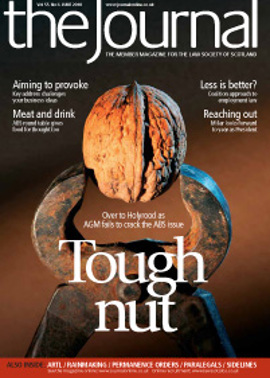Book reviews
Tolley's Corporate Manslaughter and Homicide: A Guide to Compliance
Andrea Oates
PUBLISHER: LEXISNEXIS BUTTERWORTHS
ISBN: 9780754530664
PRICE: £65
The title of this book is enticing. It suggests something particularly practical: perhaps a step-by-step guide as to how to run one’s factory, farm or railway network in such a way as to keep one’s employees safe from the risk of death – or at least keep the employer safe from the risk of prosecution in that eventuality?
Unsurprisingly, the book is not in fact a checklist of workplace safety issues. Instead, its stated aim is “to guide employers through the provisions of the Corporate Manslaughter and Corporate Homicide Act 2007”. It is a legal textbook written so as to be both accessible and useful to non-lawyers. Writing in this way is difficult, but the author appears to have succeeded without compromising on accuracy or necessary detail.
No book is without its glitches, and the account of the offence of culpable homicide in chapter 4, where it is clear that the author has struggled to reconcile conflicting sources, is not entirely satisfactory – but this is largely a consequence of the inaccessibility of Scots criminal law to the non-lawyer, an issue with which lawyers are perhaps not as concerned as they should be.
The book starts with an accessible overview of the background to the 2007 Act, including a detailed account of the Scottish position. It goes on to set out the Act’s provisions in their wider context of health and safety legislation and corporate accountability.
From chapter 9 onwards, theauthor examines the implications for particular sectors (construction, transport, agriculture, manufacturing, energy and utility supply, and public services). She draws widely on contextual material and provides frequent examples of prosecutions, which are likely to be of considerable assistance to the non-lawyer in understanding the material presented.
While this book will be of assistance to lawyers themselves, it seems also to be an example of a rare species: a legal textbook which can be recommended to clients.
- James Chalmers, University of Edinburgh
Cross Examination in Criminal Trials: 3rd Edition
Marcus Stone
PUBLISHER: BLOOMSBURY PROFESSIONAL
ISBN: 9781845921033
PRICE: £48
One of Scotland’s leading QCs has been known to introduce his masterclasses in cross examination by telling the audience that it is a skill which cannot be taught. A disappointing start to such expensive lectures but, happily, not entirely true. My legal generation learned mainly by watching and copying, but advocacy today is much more frequently the subject of serious study and formal training. I have, however, always tried to read as much as possible on the subject.
In this area, Sheriff Marcus Stone was well ahead of his time with this book, originally published in 1988. The year of 2009 saw its third edition.
The new edition, “thoroughly revised, rewritten in places and expanded”, also includes an entirely new chapter on “Applications”. This briefly and helpfully suggests how specific parts of the book may be used in relation to challenging specific types of evidence, as well as providing an overview of the book.
The third edition of course retains the comprehensive theoretical analysis of the topic, and benefits from Stone’s understanding of psychology which comes, no doubt, from his extensive experience as a sheriff as well as his formal qualification in the subject.
It starts with a basic analysis of the different sorts of crimes, using the broad categories of result, conduct and object, and proceeds to cover examination in chief as well as providing a detailed study of cross examination, both as a constructive and destructive tool in the advocate’s armoury.
The book’s 280 pages contain almost everything you could want to know on the subject, but it is a fairly dense read, especially as it provides very few examples of the techniques and problems it describes.
Although a fairly significant contribution to the area in 1988, the new edition appears at a time when there are numerous books on advocacy, as well as National Institute for Trial Advocacy (NITA)-type training. I have borrowed a little from many of the books I have read. For all its faults I return most frequently to Francis Wellman’s The Art of Cross-Examination, with its transcripts of actual evidence from real cases. Some of the NITA texts are perhaps easier to read than Stone but, as with Wellman’s book, the American aspects sometimes grate.
Advocacy comes naturally to some, but for the rest of us, at least some effort is required. If you can’t get on an advocacy training course where you can try out the techniques, I recommend that you take the time to read this book at least once. Thereafter it will be much easier to dip in for refreshers on specific aspects of your craft.
- John Scott, solicitor advocate, Capital Defence Lawyers, Edinburgh
In this issue
- Embrace "the new lawyer", mediation expert will tell conference
- Best practice governance for family businesses: a new dawn
- Spanning the divide
- Action on Gill review
- A House divided?
- Get it right first time
- Views from the front line
- Push for change
- "If ABSs are the answer, what's the question?"
- Common cause
- Shaping a new life
- Essential artl
- Smart bows out at AGM
- It's the final countdown
- Law reform update
- Ask Ash
- Here comes the rain again...
- True or false?
- Journey's end
- Win some, lose some
- Forget getting paid!
- Thumbs up for Google?
- A sporting result?
- Buying into good causes
- Scottish Solicitors' Discipline Tribunal
- Website review
- Book reviews






